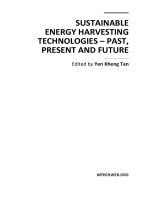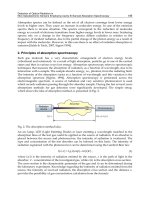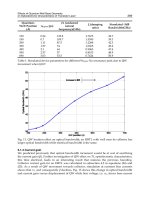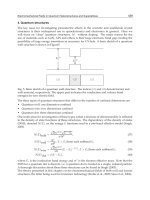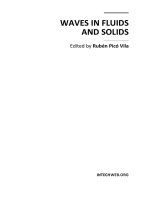Composite Materials Design and Applications Part 1 pot
Bạn đang xem bản rút gọn của tài liệu. Xem và tải ngay bản đầy đủ của tài liệu tại đây (768.07 KB, 23 trang )
COMPOSITE
MATERIALS
DESIGN AND APPLICATIONS
© 2003 by CRC Press LLC
CRC PRESS
Boca Raton London New York Washington, D.C.
COMPOSITE
MATERIALS
DESIGN AND APPLICATIONS
Daniel Gay
Suong V. Hoa
Stephen W. Tsai
© 2003 by CRC Press LLC
This book contains information obtained from authentic and highly regarded sources. Reprinted material is quoted with
permission, and sources are indicated. A wide variety of references are listed. Reasonable efforts have been made to publish
reliable data and information, but the author and the publisher cannot assume responsibility for the validity of all materials
or for the consequences of their use.
Neither this book nor any part may be reproduced or transmitted in any form or by any means, electronic or mechanical,
including photocopying, microÞlming, and recording, or by any information storage or retrieval system, without prior
permission in writing from the publisher.
The consent of CRC Press LLC does not extend to copying for general distribution, for promotion, for creating new works,
or for resale. SpeciÞc permission must be obtained in writing from CRC Press LLC for such copying.
Direct all inquiries to CRC Press LLC, 2000 N.W. Corporate Blvd., Boca Raton, Florida 33431.
Trademark Notice:
Product or corporate names may be trademarks or registered trademarks, and are used only for
identiÞcation and explanation, without intent to infringe.
Visit the CRC Press Web site at www.crcpress.com
© 2003 by CRC Press LLC
French editions published by Editions Hermès, Paris, 1997
No claim to original U.S. Government works
International Standard Book Number 1-58716-084-6
Library of Congress Card Number 2002073794
Printed in the United States of America 1 2 3 4 5 6 7 8 9 0
Printed on acid-free paper
Library of Congress Cataloging-in-Publication Data
Gay, Daniel, 1942-
[Matériaux composites. English]
Composite materials / by Daniel Gay ; translated by Suong V. Hoa, Stephen W. Tsai.
p. cm.
Translation of: Matériaux composites. 4th ed.
Includes bibliographical references and index.
ISBN 1-58716-084-6 (alk. paper)
1. Composite materials. I. Title.
TA418.9.C6 G39 2002
620.1
′
18—dc21 2002073794
CIP
TX846 disclaimer Page iv Friday, November 8, 2002 8:38 AM
© 2003 by CRC Press LLC
PREFACE
The economic importance of composite materials is now well known. There are
strong indications everywhere that this importance will be increasing in the future.
Composite materials now occupy an established position in the aerospace industry.
They are also used for many components in the automotive industry and civil
infrastructures now have their reinforcements made of composite materials. There
is a large range of manufacturing processes for the production of low-cost compo-
sites.
There is a need by engineers working in composites for a practical source of
reference for the design and application of composites. This book fills that need.
In the educational sector, composite materials now are taught at many universities
around the world. Usually the topic covered is laminate theory. Composites Design
courses also exist in a few universities and institutes. The demand from students
and also practitioners of composites for knowledge and training in design of
composites is increasing. However a good design book has not been available.
The content of these design courses concentrates mostly on analysis while appli-
cations still remain at the specimen level.
This book, initially written by Daniel Gay in French, has been distributed
widely in France and in French speaking countries. The authors are of the opinion
that having the book in the English language would facilitate the training and
dissemination of knowledge to the regions where composites are used the most.
The book has been translated to English with modifications and updates. The
book consists of four main parts, with increasing levels of complexity. Each part
can be studied independently from the other parts.
Ⅲ
The first part
presents an introduction to composite materials, the fabrica-
tion processes, the properties of a single ply, sandwich materials, concep-
tual design, assembly, and applications of composites in the aerospace
and other areas. This part can be used by itself to form a part of a course
on advanced materials and associated designs.
Ⅲ
The second part
presents the mechanics of composite materials. This consists
of discussion on elastic anisotropic properties, the directional dependence
of different properties, and mechanical properties of thin laminates. This
part can be used by itself to teach students and engineers on the mechanics
of composite materials.
Ⅲ
The third part
presents the orthotropic coefficients that may be conveniently
used for design. The Hill–Tsai failure criterion, bending of composite beams,
torsion of composite beams, and bending of thick composite plates. This
part requires knowledge of strength of materials. Information presented here
is more theoretical than in preceding parts. Its main objective is to contribute
to a better interpretation of the behavior of composite components.
TX846_Frame_FM Page v Thursday, July 11, 2002 5:38 PM
© 2003 by CRC Press LLC
Ⅲ
The fourth part
provides numerous (41) numerical examples on the use
and design of composites. There are three levels of examples. Level 1 deals
with the determination of mechanical properties of composite structures
in different forms such as plates, tubes, or composite components made
using different processes such as hand-lay-up or filament winding. Level
2 deals with thermoelastic properties of different laminates. Failure analysis
is also carried out. Level 3 deals with bonding of cylinders made of compo-
sites, buckling of composite sandwich beams, flexural shear in sandwich
beams, vibrations of composite
This volume can be used to teach students at the first year graduate level as
well as the final year undergraduate level. It is also useful for practical engineers
who want to learn, on the job, the guidelines for the use of composites in their
applications. The authors hope that this volume can make significant contribution
to the training of future engineers who utilize composites.
Suong V. Hoa
Montreal, Quebec, Canada
Daniel Gay
Toulouse, France
Stephen Tsai
Stanford, California
July 2002
TX846_Frame_FM Page vi Thursday, July 11, 2002 5:38 PM
© 2003 by CRC Press LLC
CONTENTS
PART I: PRINCIPLES OF CONSTRUCTION
1 Composite Materials, Interest, and Properties
1.1 What Is Composite Material?
1.2 Fibers and Matrix
1.2.1 Fibers
1.2.2 Matrix Materials
1.3 What Can Be Made Using Composite Materials?
1.4 Typical Examples of Interest on the Use of Composite Materials
1.5 Examples on Replacing Conventional Solutions with Composites
1.6 Principal Physical Properties
2 Fabrication Processes
2.1 Molding Processes
2.1.1 Contact Molding
2.1.2 Compression Molding
2.1.3 Molding with Vacuum
2.1.4 Resin Injection Molding
2.1.5 Molding by Injection of Premixed
2.1.6 Molding by Foam Injection
2.1.7 Molding of Components of Revolution
2.2 Other Forming Processes
2.2.1 Sheet Forming
2.2.2 Profile Forming
2.2.3 Stamp Forming
2.2.4 Preforming by Three-Dimensional Assembly
2.2.5 Cutting of Fabric and Trimming of Laminates
2.3 Practical Hints on Manufacturing Processes
2.3.1 Acronyms
2.3.2 Cost Comparison
3 Ply Properties
3.1 Isotropy and Anisotropy
3.1.1 Isotropic Materials
3.1.2 Anisotropic Material
3.2 Characteristics of the Reinforcement–Matrix Mixture
3.2.1 Fiber Mass Fraction
3.2.2 Fiber Volume Fraction
3.2.3 Mass Density of a Ply
3.2.4 Ply Thickness
TX846_Frame_FM Page vii Thursday, July 11, 2002 5:38 PM
© 2003 by CRC Press LLC
3.3 Unidirectional Ply
3.3.1 Elastic Modulus
3.3.2 Ultimate Strength of a Ply
3.3.3 Examples
3.3.4 Examples of “High Performance” Unidirectional Plies
3.4 Woven Fabrics
3.4.1 Forms of Woven Fabric
3.4.2 Elastic Modulus of Fabric Layer
3.4.3 Examples of Balanced Fabrics/Epoxy
3.5 Mats and Reinforced Matrices
3.5.1 Mats
3.5.2 Summary Example of Glass/Epoxy Layers
3.5.3 Spherical Fillers
3.5.4 Other Reinforcements
3.6 Multidimensional Fabrics
3.7 Metal Matrix Composites
3.8 Tests
4 Sandwich Structures
4.1 What Is a Sandwich Structure?
4.2 Simplified Flexure
4.2.1 Stresses
4.2.2 Displacements
4.3 A Few Special Aspects
4.3.1 Comparison of Mass Based on Equivalent Flexural Rigidity (EI)
4.3.2 Buckling of Sandwich Structures
4.3.3 Other Types of Damage
4.4 Fabrication and Design Problems
4.4.1 Honeycomb: An Example of Core Material
4.4.2 Processing Aspects
4.4.3 Insertion of Attachment Pieces
4.4.4 Repair of Laminated Facings
4.5 Nondestructive Quality Control
5 Conception and Design
5.1 Design of a Composite Piece
5.1.1 Guidelines for Values for Predesign
5.2 The Laminate
5.2.1 Unidirectional Layers and Fabrics
5.2.2 Importance of Ply Orientation
5.2.3 Code to Represent a Laminate
5.2.4 Arrangement of Plies
5.3 Failure of Laminates
5.3.1 Damages
5.3.2 Most Frequently Used Criterion: Hill–Tsai Failure Criterion
5.4 Sizing of the Laminate
5.4.1 Modulus of Elasticity. Deformation of a Laminate
5.4.2 Case of Simple Loading
5.4.3 Case of Complex Loading—Approximate Orientation
Distribution of a Laminate
5.4.4 Case of Complex Loading: Optimum Composition of a Laminate
5.4.5 Practical Remarks: Particularities of the Behavior of Laminates
TX846_Frame_FM Page viii Thursday, July 11, 2002 5:38 PM
© 2003 by CRC Press LLC
6 Joining and Assembly
6.1 Riveting and Bolting
6.1.1 Principal Modes of Failure in Bolted Joints
for Composite Materials
6.1.2 Recommended Values
6.1.3 Riveting
6.1.4 Bolting
6.2 Bonding
6.2.1 Adhesives Used
6.2.2 Geometry of the Bonded Joints
6.2.3 Sizing of Bonded Surfaces
6.2.4 Examples of Bonding
6.3 Inserts
7 Composite Materials and Aerospace Construction
7.1 Aircraft
7.1.1 Composite Components in Aircraft
7.1.2 Characteristics of Composites
7.1.3 A Few Remarks
7.1.4 Specific Aspects of Structural Resistance
7.1.5 Large Carriers
7.1.6 Regional Jets
7.1.7 Light Aircraft
7.1.8 Fighter Aircraft
7.1.9 Architecture of Composite Parts in Aircraft
7.1.10 Elements of Braking
7.1.11 The Future
7.2 Helicopters
7.2.1 The Situation
7.2.2 Composite Zones
7.2.3 Blades
7.2.4 Yoke Rotor
7.2.5 Other Composite Working Components
7.3 Propeller Blades for Airplanes
7.4 Turbine Blades in Composites
7.5 Space Applications
7.5.1 Satellites
7.5.2 Pressure Vessels
7.5.3 Nozzles
7.5.4 Other Composite Components
8 Composite Materials for Other Applications
8.1 Composite Materials and the Manufacturing of Automobiles
8.1.1 Introduction
8.1.2 Evaluation and Evolution
8.1.3 Research and Development
8.2 Composites in Naval Construction
8.2.1 Competition
8.2.2 Ships
8.3 Sports and Recreation
8.3.1 Skis
8.3.2 Bicycles
TX846_Frame_FM Page ix Thursday, July 11, 2002 5:38 PM
© 2003 by CRC Press LLC
8.4 Other Applications
8.4.1 Wind Turbines
8.4.2 Compressed Gas Bottles
8.4.3 Buggy Chassis
8.4.4 Tubes for Off-Shore Installations
8.4.5 Biomechanics Applications
8.4.6 Telepherique Cabin
PART II: MECHANICAL BEHAVIOR OF LAMINATED MATERIALS
9 Anisotropic Elastic Media
9.1 Review of Notations
9.1.1 Continuum Mechanics
9.1.2 Number of Distinct
ϕ
ijk
ᐉ
Terms
9.2 Orthotropic Materials
9.3 Transversely Isotropic Materials
10 Elastic Constants of Unidirectional Composites
10.1 Longitudinal Modulus
E
ᐉ
10.2 Poisson Coefficient
10.3 Transverse Modulus
E
t
10.4 Shear Modulus
G
ᐉ
t
10.5 Thermoelastic Properties
10.5.1 Isotropic Material: Recall
10.5.2 Case of Unidirectional Composite
10.5.3 Thermomechanical Behavior of a Unidirectional Layer
11 Elastic Constants of a Ply Along an Arbitrary Direction
11.1 Compliance Coefficients
11.2 Stiffness Coefficients
11.3 Case of Thermomechanical Loading
11.3.1 Compliance Coefficients
11.3.2 Stiffness Coefficients
12 Mechanical Behavior of Thin Laminated Plates
12.1 Laminate with Midplane Symmetry
12.1.1 Membrane Behavior
12.1.2 Apparent Moduli of the Laminate
12.1.3 Consequence: Practical Determination of a Laminate Subject
to Membrane Loading
12.1.4 Flexure Behavior
12.1.5 Consequence: Practical Determination for a Laminate Subject to Flexure
12.1.6 Simplified Calculation for Flexure
12.1.7 Case of Thermomechanical Loading
12.2 Laminate without Midplane Symmetry
12.2.1 Coupled Membrane–Flexure Behavior
12.2.2 Case of Thermomechanical Loading
PART III: JUSTIFICATIONS, COMPOSITE BEAMS, AND THICK PLATES
13 Elastic Coefficients
13.1 Elastic Coefficients in an Orthotropic Material
13.2 Elastic Coefficients for a Transversely Isotropic Material
13.2.1 Rotation about an Orthotropic Transverse Axis
13.3 Case of a Ply
TX846_Frame_FM Page x Thursday, July 11, 2002 5:38 PM
© 2003 by CRC Press LLC
14 The Hill–Tsai Failure Criterion
14.1 Isotropic Material: Von Mises Criterion
14.2 Orthotropic Material: Hill–Tsai Criterion
14.2.1 Preliminary Remarks
14.2.2 Case of a Transversely Isotropic Material
14.2.3 Case of a Unidirectional Ply Under In-Plane Loading
14.3 Variation of Resistance of a Unidirectional Ply with Respect
to the Direction of Loading
14.3.1 Tension and Compression Resistance
14.3.2 Shear Strength
15 Composite Beams in Flexure
15.1 Flexure of Symmetric Beams with Isotropic Phases
15.1.1 Degrees of Freedom
15.1.2 Perfect Bonding between the Phases
15.1.3 Equilibrium Relations
15.1.4 Constitutive Relations
15.1.5 Technical Formulation
15.1.6 Energy Interpretation
15.1.7 Extension to the Dynamic Case
15.2 Case of Any Cross Section (Asymmetric)
16 Composite Beams in Torsion
16.1 Uniform Torsion
16.1.1 Torsional Degree of Freedom
16.1.2 Constitutive Relation
16.1.3 Determination of the Function
Φ
(
y
,
z
)
16.1.4 Energy Interpretation
16.2 Location of the Torsion Center
17 Flexure of Thick Composite Plates
17.1 Preliminary Remarks
17.1.1 Transverse Normal Stress
σ
z
17.1.2 Transverse Shear Stresses
τ
xz
and
τ
yz
17.1.3 Hypotheses
17.2 Displacement Field
17.3 Strains
17.4 Constitutive Relations
17.4.1 Membrane Equations
17.4.2 Bending Behavior
17.4.3 Transverse Shear Equation
17.5 Equilibrium Equations
17.5.1 Transverse Equilibrium
17.5.2 Equilibrium in Bending
17.6 Technical Formulation for Bending
17.6.1 Plane Stresses Due to Bending
17.6.2 Transverse Shear Stresses in Bending
17.6.3 Characterization of the Bending, Warping Increments
η
x
and
η
y
17.6.4 Warping Functions
17.6.5 Consequences
17.6.6 Interpretation in Terms of Energy
17.7 Examples
17.7.1 Homogeneous Orthotropic Plate
17.7.2 Sandwich Plate
TX846_Frame_FM Page xi Thursday, July 11, 2002 5:38 PM
© 2003 by CRC Press LLC
PART IV: APPLICATIONS
18 Applications
18.1 Level 1
18.1.1 Simply Supported Sandwich Beam
18.1.2 Poisson Coefficient of a Unidirectional Layer
18.1.3 Helicopter Blade
18.1.4 Transmission Shaft for Trucks
18.1.5 Flywheel in Carbon/Epoxy
18.1.6 Wing Tip Made of Carbon/Epoxy
18.1.7 Carbon Fiber Coated with Nickel
18.1.8 Tube Made of Glass/Epoxy under Pressure
18.1.9 Filament Wound Vessel, Winding Angle
18.1.10 Filament Wound Reservoir, Taking the Heads into Account
18.1.11 Determination of the Volume Fraction of Fibers by Pyrolysis
18.1.12 Lever Arm Made of Carbon/PEEK Unidirectional and Short Fibers
18.1.13 Telegraphic Mast in Glass/Resin
18.1.14 Unidirectional Ply of HR Carbon
18.1.15 Manipulator Arm of Space Shuttle
18.2 Level 2
18.2.1 Sandwich Beam: Simplified Calculation of the Shear Coefficient
18.2.2 Procedure for Calculation of a Laminate
18.2.3 Kevlar/Epoxy Laminates: Evolution of Stiffness Depending
on the Direction of the Load
18.2.4 Residual Thermal Stresses due to Curing of the Laminate
18.2.5 Thermoelastic Behavior of a Tube Made of Filament-Wound
Glass/Polyester
18.2.6 Polymeric Tube Loaded by Thermal Load and Creep
18.2.7 First Ply Fracture of a Laminate—Ultimate Rupture
18.2.8 Optimum Laminate for Isotropic Stress State
18.2.9 Laminate Made of Identical Layers of Balanced Fabric
18.2.10 Wing Spar in Carbon/Epoxy
18.2.11 Determination of the Elastic Characteristics of a Carbon/Epoxy
Unidirectional Layer from Tensile Test
18.2.12 Sailboat Shell in Glass/Polyester
18.2.13 Determination of the In-Plane Shear Modulus of a
Balanced Fabric Ply
18.2.14 Quasi-Isotropic Laminate
18.2.15 Orthotropic Plate in Pure Torsion
18.2.16 Plate Made by Resin Transfer Molding (R.T.M.)
18.2.17 Thermoelastic Behavior of a Balanced Fabric Ply
18.3 Level 3
18.3.1 Cylindrical Bonding
18.3.2 Double Bonded Joint
18.3.3 Composite Beam with Two Layers
18.3.4 Buckling of a Sandwich Beam
18.3.5 Shear Due to Bending in a Sandwich Beam
18.3.6 Column Made of Stretched Polymer
18.3.7 Cylindrical Bending of a Thick Orthotropic Plate under
Uniform Loading
18.3.8 Bending of a Sandwich Plate
18.3.9 Bending Vibration of a Sandwich Beam
TX846_Frame_FM Page xii Thursday, July 11, 2002 5:38 PM
© 2003 by CRC Press LLC
APPENDICES, BIBLIOGRAPHY, AND INDEX
Appendix 1
Stresses in the Plies of a Laminate of Carbon/Epoxy Loaded in Its Plane
Characteristics of Each Ply
Appendix 2
Buckling of Orthotropic Structures
Rectangular Panels
Buckling of Orthotropic Tubes
Bibliography
TX846_Frame_FM Page xiii Thursday, July 11, 2002 5:38 PM
© 2003 by CRC Press LLC
PART I
PRINCIPLES OF
CONSTRUCTION
TX846_Frame_C01 Page 1 Monday, November 18, 2002 10:34 AM
© 2003 by CRC Press LLC
1
COMPOSITE MATERIALS,
INTEREST, AND PROPERTIES
1.1 WHAT IS COMPOSITE MATERIAL?
As the term indicates,
composite
material
reveals a material that is different from
common heterogeneous materials. Currently
composite materials
refers to materials
having strong fibers—continuous or noncontinuous—surrounded by a weaker
matrix material. The matrix serves to distribute the fibers and also to transmit the
load to the fibers.
Notes:
Composite materials are not new. They have been used since antiquity.
Wood and cob have been everyday composites. Composites have also been used
to optimize the performance of some conventional weapons. For example:
Ⅲ
In the Mongolian arcs, the compressed parts are made of corn, and the
stretched parts are made of wood and cow tendons glued together.
Ⅲ
Japanese swords or sabers have their blades made of steel and soft iron:
the steel part is stratified like a sheet of paste, with orientation of defects
and impurities in the long direction
1
(see Figure 1.1), then formed into a
U shape into which the soft iron is placed. The sword then has good
resistance for flexure and impact.
One can see in this period the beginning of the distinction between the common
composites used universally and the high performance composites.
The composite material as obtained is
Ⅲ
Very heterogeneous.
Ⅲ
Very “anisotropic.” This notion of “anisotropy” will be illustrated later in
Section 3.1 and also in Chapter 9. Simply put this means that the mechanical
properties of the material depend on the direction.
1
In folding a sheet of steel over itself 15 times, one obtains 2
15
=
32,768 layers.
TX846_Frame_C01 Page 3 Monday, November 18, 2002 10:34 AM
© 2003 by CRC Press LLC
Ⅲ
Unidimensional:
unidirectional tows, yarns, or tapes
Ⅲ
Bidimensional:
woven or nonwoven fabrics (felts or mats)
Ⅲ
Tridimensional:
fabrics (sometimes called
multidimensional fabrics
) with
fibers oriented along many directions (
>
2)
Before the formation of the reinforcements, the fibers are subjected to a surface
treatment to
Ⅲ
Decrease the abrasion action of fibers when passing through the forming
machines.
Ⅲ
Improve the adhesion with the matrix material.
Other types of reinforcements, full or empty spheres (microspheres) or powders
(see Section 3.5.3), are also used.
1.2.1.1 Relative Importance of Different Fibers in Applications
Figure 1.3 allows one to judge the relative importance in terms of the amount of
fibers used in the fabrication of composites. One can immediately notice the
industrial importance of fiber glass (produced in large quantities). Carbon and
Kevlar fibers are reserved for high performance components.
Following are a few notes on the fibers:
Ⅲ
Glass fiber: The filaments are obtained by pulling the glass (silicon
+
sodium
carbonate and calcium carbonate;
T
>
1000
∞
C) through the small orifices of
a plate made of platinum alloy.
Ⅲ
Kevlar fiber: This is an aramid fiber, yellowish color, made by DuPont de
Nemours (USA). These are aromatic polyamides obtained by synthesis at
-
10
∞
C, then fibrillated and drawn to obtain high modulus of elasticity.
Ⅲ
Carbon fiber: Filaments of polyacrylonitrile or pitch (obtained from residues
of the petroleum products) are oxidized at high temperatures (300
∞
C), then
heated further to 1500
∞
C in a nitrogen atmosphere. Then only the hexagonal
Figure 1.2 Different Fiber Forms
TX846_Frame_C01 Page 5 Monday, November 18, 2002 10:34 AM
© 2003 by CRC Press LLC
1.2.2 Matrix Materials
The matrix materials include the following:
Ⅲ
Polymeric matrix:
thermoplastic resins (polypropylene, polyphenylene
sulfone, polyamide, polyetheretherketone, etc.) and thermoset resins (poly-
esters, phenolics, melamines, silicones, polyurethanes, epoxies). Their prin-
cipal physical properties are indicated in the Table 1.4.
Ⅲ
Mineral matrix:
silicon carbide, carbon. They can be used at high tem-
peratures (see Sections 2.2.4, 3.6, 7.1.10, 7.5).
Ⅲ
Metallic matrix:
aluminum alloys, titanium alloys, oriented eutectics.
1.3 WHAT CAN BE MADE USING COMPOSITE MATERIALS?
The range of applications is very large. A few examples are shown below.
Ⅲ
Electrical, Electronics
Ⅲ
Insulation for electrical construction
Ⅲ
Supports for circuit breakers
Ⅲ
Supports for printed circuits
Ⅲ
Armors, boxes, covers
Ⅲ
Antennas, radomes
Ⅲ
Tops of television towers
Ⅲ
Cable tracks
Ⅲ
Windmills
Ⅲ
Buildings and Public Works
Ⅲ
Housing cells
Ⅲ
Chimneys
Ⅲ
Concrete molds
Ⅲ
Various covers (domes, windows, etc.)
Ⅲ
Swimming pools
Ⅲ
Facade panels
Ⅲ
Profiles
Ⅲ
Partitions, doors, furniture, bathrooms
Ⅲ
Road Transports
Ⅲ
Body components
Ⅲ
Complete body
Ⅲ Wheels, shields, radiator grills,
Ⅲ Transmission shafts
Ⅲ Suspension springs
Ⅲ Bottles for compressed petroleum gas
Ⅲ Chassis
Ⅲ Suspension arms
Ⅲ Casings
Ⅲ Cabins, seats
Ⅲ Highway tankers, isothermal trucks
Ⅲ Trailers
TX846_Frame_C01 Page 7 Monday, November 18, 2002 10:34 AM
© 2003 by CRC Press LLC
Ⅲ Rail transports:
Ⅲ Fronts of power units
Ⅲ Wagons
Ⅲ Doors, seats, interior panels
Ⅲ Ventilation housings
Ⅲ Marine Transports:
Ⅲ Hovercrafts
Ⅲ Rescue crafts
Ⅲ Patrol boats
Ⅲ Trawlers
Ⅲ Landing gears
Ⅲ Anti-mine ships
Ⅲ Racing boats
Ⅲ Pleasure boats
Ⅲ Canoes
Ⅲ Cable transports:
Ⅲ Telepherique cabins
Ⅲ Telecabins
Ⅲ Air transports
Ⅲ All composite passenger aircrafts
Ⅲ All composite gliders
Ⅲ Many aircraft components: radomes, leading edges, ailerons, vertical
stabilizers
Ⅲ Helicopter blades, propellers
Ⅲ Transmission shafts
Ⅲ Aircraft brake discs
Ⅲ Space Transports
Ⅲ Rocket boosters
Ⅲ Reservoirs
Ⅲ Nozzles
Ⅲ Shields for atmosphere reentrance
Ⅲ General mechanical applications
Ⅲ Gears
Ⅲ Bearings
Ⅲ Housings, casings
Ⅲ Jack body
Ⅲ Robot arms
Ⅲ Fly wheels
Ⅲ Weaving machine rods
Ⅲ Pipes
Ⅲ Components of drawing table
Ⅲ Compressed gas bottles
Ⅲ Tubes for offshore platforms
Ⅲ Pneumatics for radial frames
Ⅲ Sports and Recreation
Ⅲ Tennis and squash rackets
Ⅲ Fishing poles
Ⅲ Skis
TX846_Frame_C01 Page 8 Monday, November 18, 2002 10:34 AM
© 2003 by CRC Press LLC
Ⅲ Poles used in jumping
Ⅲ Sails
Ⅲ Surf boards,
Ⅲ Roller skates
Ⅲ Bows and arrows
Ⅲ Javelins
Ⅲ Protection helmets
Ⅲ Bicycle frames
Ⅲ Golf clubs
Ⅲ Oars
1.4 TYPICAL EXAMPLES OF INTEREST ON THE USE
OF COMPOSITE MATERIALS
In the domain of commercial aircraft, one can compare the concerns of manufac-
turers with the principal characteristic properties of composite materials. The
concerns of the manufacturers are performance and economy. The characteristics
of composite components include the following:
Ⅲ Weight saving leads to fuel saving, increase in payload, or increase in range
which improves performances.
Ⅲ Good fatigue resistance leads to enhanced life which involves saving in the
long-term cost of the product.
Ⅲ Good corrosion resistance means fewer requirements for inspection which
results in saving on maintenance cost.
Moreover, taking into account the cost of the composite solution as compared with
the conventional solution, one can state that composites fit the demand of aircraft
manufacturers.
1.5 EXAMPLES ON REPLACING CONVENTIONAL
SOLUTIONS WITH COMPOSITES
Table 1.1 shows a few significant cases illustrating the improvement on price and
performance that can be obtained after replacement of a conventional solution
with a composite solution.
1.6 PRINCIPAL PHYSICAL PROPERTIES
Tables 1.2 through 1.5 take into account the properties of only individual com-
ponents, reinforcements, or matrices. The characteristics of composite materials
resulting from the combination of reinforcement and matrix depend on
Ⅲ The proportions of reinforcements and matrix (see Section 3.2)
Ⅲ The form of the reinforcement (see Section 3.2)
Ⅲ The fabrication process
TX846_Frame_C01 Page 9 Monday, November 18, 2002 10:34 AM
© 2003 by CRC Press LLC
Table 1.3 Properties of Commonly Used Reinforcements
Reinforcements
Fiber
Diameter
d(
m
m)
Density
r
(kg/m
3
)
Modulus of
Elasticity
E(Mpa)
Shear
Modulus
G(Mpa)
Poisson
Ratio
n
Tensile
Strength
s
Ult
(Mpa)
Elongation
E(%)
Coefficient of
Thermal
Expansion
a
(∞C
-1
)
Coefficient
of Thermal
Conductivity
l(W/M∞C)
Heat
Capacity
c(J/kg˚C)
Useful
Temperature
Limit T
max
(∞C)
Price
1993
($/kg)
“R” glass,
high
performance
10 2500 86,000 0.2 3200 4 0.3 ¥ 10
-5
1 800 700 14
“E” glass,
common
applications
16 2600 74,000 30,000 0.25 2500 3.5 0.5 ¥ 10
-5
1 800 700 2
Kevlar 49 12 1450 130,000 12,000 0.4 2900 2.3 -0.2 ¥ 10
-5
0.03 1400 70
“HT”
graphite,
high
strength
7 1750 230,000 50,000 0.3 3200 1.3 0.02 ¥ 10
-5
200 (20∞C)
60 (800∞C)
800 >1500 70
“HM”
graphite,
high
modulus
6.5 1800 390,000 20,000 0.35 2500 0.6 0.08 ¥ 10
-5
200 (20∞C)
60 (800∞C)
800 >1500 140
Boron 100 2600 400,000 3400 0.8 0.4 ¥ 10
-5
500 500
Aluminum 20 3700 380,000 1400 0.4 50 (20∞C)
7 (800∞C)
900 >1000
Aluminum
silicate
10 2600 200,000 3000 1.5
Silicon
carbide
14 2550 200,000 2800 1.3 0.5 ¥ 10
-5
1300 600
Polyethylene 960 100,000 3000 150
TX846_Frame_C01 Page 12 Monday, November 18, 2002 10:34 AM
© 2003 by CRC Press LLC
Figure 1.5 Tensile Strength of Glass/Resin Composites
Figure 1.6 Specific Strength of Different Composites
TX846_Frame_C01 Page 15 Monday, November 18, 2002 10:34 AM
© 2003 by CRC Press LLC
2
FABRICATION PROCESSES
The mixture of reinforcement/resin does not really become a composite material
until the last phase of the fabrication, that is, when the matrix is hardened. After
this phase, it would be impossible to modify the material, as in the way one would
like to modify the structure of a metal alloy using heat treatment, for example.
In the case of polymer matrix composites, this has to be polymerized, for example,
polyester resin. During the solidification process, it passes from the liquid state to
the solid state by copolymerization with a monomer that is mixed with the resin.
The phenomenon leads to hardening. This can be done using either a chemical
(accelerator) or heat. The following pages will describe the principal processes for
the formation of composite parts.
2.1 MOLDING PROCESSES
The flow chart in Figure 2.1 shows the steps found in all molding processes.
Forming by molding processes varies depending on the nature of the part, the
number of parts, and the cost. The mold material can be made of metal, polymer,
wood, or plaster.
2.1.1 Contact Molding
Contact molding (see Figure 2.2) is open molding (there is only one mold, either
male or female). The layers of fibers impregnated with resin (and accelerator) are
placed on the mold. Compaction is done using a roller to squeeze out the air
pockets. The duration for resin setting varies, depending on the amount of accel-
erator, from a few minutes to a few hours. One can also obtain parts of large
dimensions at the rate of about 2 to 4 parts per day per mold.
2.1.2 Compression Molding
With compression molding (see Figure 2.3), the countermold will close the mold
after the impregnated reinforcements have been placed on the mold. The whole
assembly is placed in a press that can apply a pressure of 1 to 2 bars. The
polymerization takes place either at ambient temperature or higher.
The process is good for average volume production: one can obtain several
dozen parts a day (up to 200 with heating). This has application for automotive
and aerospace parts.
TX846_Frame_C02 Page 17 Monday, November 18, 2002 10:40 AM
© 2003 by CRC Press LLC
2.1.3 Molding with Vacuum
This process of molding with vacuum is still called
depression molding
or
bag
molding
. As in the case of contact molding described previously, one uses an
open mold on top of which the impregnated reinforcements are placed. In the
case of sandwich materials, the cores are also used (see Chapter 4). One sheet
of soft plastic is used for sealing (this is adhesively bonded to the perimeter of
the mold). Vacuum is applied under the piece of plastic (see Figure 2.4). The
piece is then compacted due to the action of atmospheric pressure, and the air
bubbles are eliminated. Porous fabrics absorb excess resin. The whole material
is polymerized by an oven or by an autoclave under pressure (7 bars in the case
of carbon/epoxy to obtain better mechanical properties), or with heat, or with
electron beam, or x-rays; see Figure 2.5). This process has applications for aircraft
structures, with the rate of a few parts per day (2 to 4).
Figure 2.4 Vacuum Molding
Figure 2.5 Electron Beam or X-ray Molding
TX846_Frame_C02 Page 19 Monday, November 18, 2002 10:40 AM
© 2003 by CRC Press LLC
2.1.4 Resin Injection Molding
With resin injection molding (see Figure 2.6), the reinforcements (mats, fabrics) are
put in place between the mold and countermold. The resin (polyester or phenolic)
is injected. The mold pressure is low. This process can produce up to 30 pieces
per day. The investment is less costly and has application in automobile bodies.
2.1.5 Molding by Injection of Premixed
The process of molding by injection of premixed allows automation of the
fabrication cycle (rate of production up to 300 pieces per day).
Ⅲ
Thermoset resins:
Can be used to make components of auto body. The
schematic of the process is shown in Figure 2.7.
Ⅲ
Thermoplastic resins:
Can be used to make mechanical components
with high temperature resistance, as shown in Figure 2.8.
Figure 2.6 Resin Injection Molding
Figure 2.7 Injection of Premixed
Figure 2.8 Injection of Thermoplastic Premixed
TX846_Frame_C02 Page 20 Monday, November 18, 2002 10:40 AM
© 2003 by CRC Press LLC
